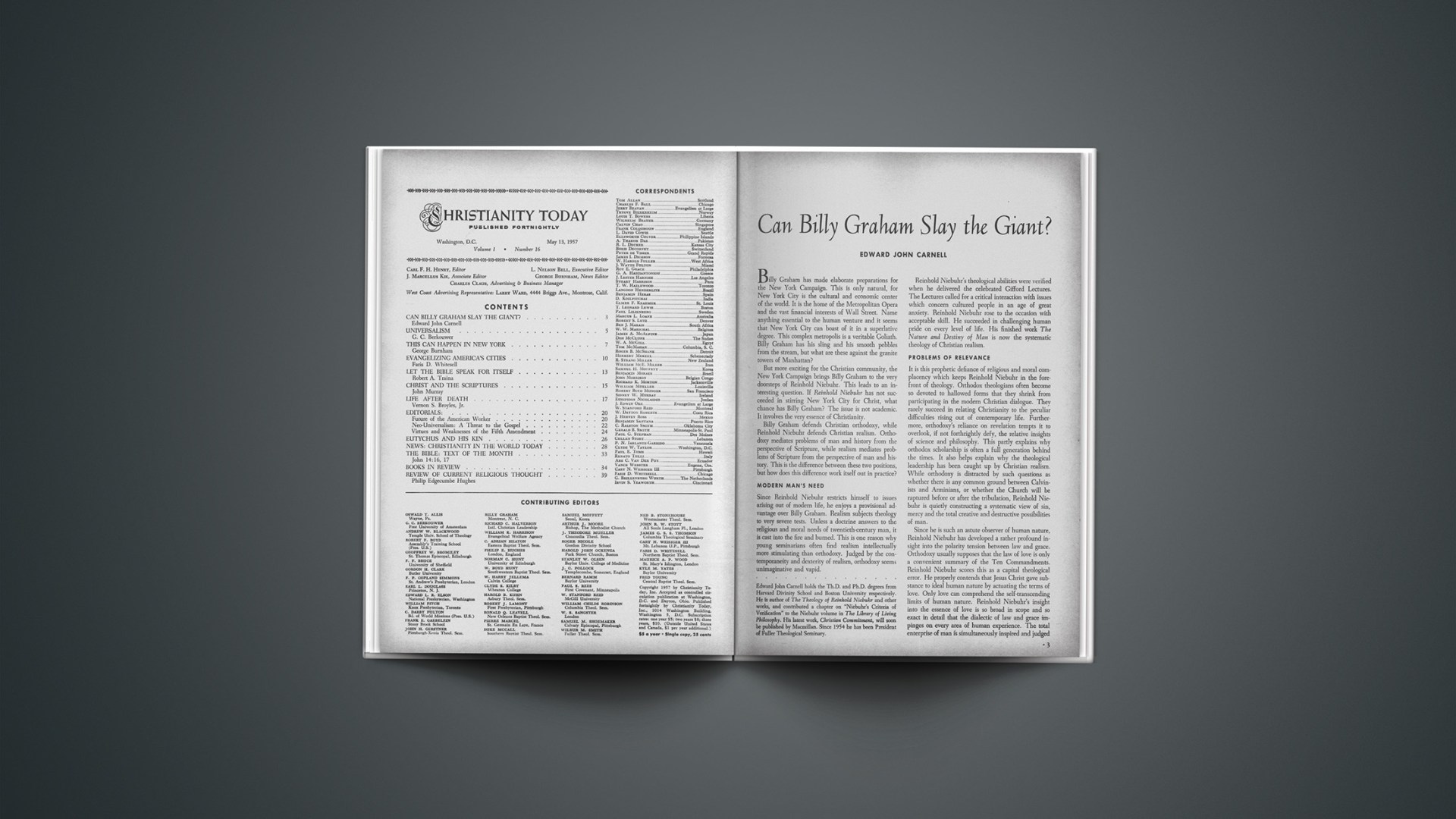Billy Graham has made elaborate preparations for the New York Campaign. This is only natural, for New York City is the cultural and economic center of the world. It is the home of the Metropolitan Opera and the vast financial interests of Wall Street. Name anything essential to the human venture and it seems that New York City can boast of it in a superlative degree. This complex metropolis is a veritable Goliath. Billy Graham has his sling and his smooth pebbles from the stream, but what are these against the granite towers of Manhattan?
But more exciting for the Christian community, the New York Campaign brings Billy Graham to the very doorsteps of Reinhold Niebuhr. This leads to an interesting question. If Reinhold Niebuhr has not succeeded in stirring New York City for Christ, what chance has Billy Graham? The issue is not academic. It involves the very essence of Christianity.
Billy Graham defends Christian orthodoxy, while Reinhold Niebuhr defends Christian realism. Orthodoxy mediates problems of man and history from the perspective of Scripture, while realism mediates problems of Scripture from the perspective of man and history. This is the difference between these two positions, but how does this difference work itself out in practice?
Modern Man’S Need
Since Reinhold Niebuhr restricts himself to issues arising out of modern life, he enjoys a provisional advantage over Billy Graham. Realism subjects theology to very severe tests. Unless a doctrine answers to the religious and moral needs of twentieth-century man, it is cast into the fire and burned. This is one reason why young seminarians often find realism intellectually more stimulating than orthodoxy. Judged by the contemporaneity and dexterity of realism, orthodoxy seems unimaginative and vapid.
Reinhold Niebuhr’s theological abilities were verified when he delivered the celebrated Gifford Lectures. The Lectures called for a critical interaction with issues which concern cultured people in an age of great anxiety. Reinhold Niebuhr rose to the occasion with acceptable skill. He succeeded in challenging human pride on every level of life. His finished work The Nature and Destiny of Man is now the systematic theology of Christian realism.
Problems Of Relevance
It is this prophetic defiance of religious and moral complacency which keeps Reinhold Niebuhr in the forefront of theology. Orthodox theologians often become so devoted to hallowed forms that they shrink from participating in the modern Christian dialogue. They rarely succeed in relating Christianity to the peculiar difficulties rising out of contemporary life. Furthermore, orthodoxy’s reliance on revelation tempts it to overlook, if not forthrightly defy, the relative insights of science and philosophy. This partly explains why orthodox scholarship is often a full generation behind the times. It also helps explain why the theological leadership has been caught up by Christian realism. While orthodoxy is distracted by such questions as whether there is any common ground between Calvinists and Arminians, or whether the Church will be raptured before or after the tribulation, Reinhold Niebuhr is quietly constructing a systematic view of sin, mercy and the total creative and destructive possibilities of man.
Since he is such an astute observer of human nature, Reinhold Niebuhr has developed a rather profound insight into the polarity tension between law and grace. Orthodoxy usually supposes that the law of love is only a convenient summary of the Ten Commandments. Reinhold Niebuhr scores this as a capital theological error. He properly contends that Jesus Christ gave substance to ideal human nature by actuating the terms of love. Only love can comprehend the self-transcending limits of human nature. Reinhold Niebuhr’s insight into the essence of love is so broad in scope and so exact in detail that the dialectic of law and grace impinges on every area of human experience. The total enterprise of man is simultaneously inspired and judged by the heights of love in Christ Jesus.
I cheerfully acknowledge a personal indebtedness to Reinhold Niebuhr. It was only as I studied Christian realism, long after I graduated from seminary, that I began to sense the power of pride and pretense in my life. Orthodoxy has an easy conscience about its own sins because it does not understand the connection between Christ’s active obedience and the total creative and destructive possibilities of man.
The Relevance Of Realism
But back to the problem of the New York Campaign. Since Billy Graham defends the traditions of orthodoxy, it would seem that his prospects of stirring Manhattan for Christ are not very good. But this need not necessarily be the case and for a very convincing reason.
When the man on the street asks about the plan of salvation, he receives very little precise guidance from the theology of Reinhold Niebuhr. This, I assert, is the grand irony of Christian realism. Reinhold Niebuhr can prove that man is a sinner, but man already knows this. Reinhold Niebuhr can develop the dialectical relation between time and eternity, but this is beyond the tether of a dime store clerk or a hod carrier. When it comes to the acid test, therefore, realism is not very realistic after all. A concrete view of sin converts to an abstract view of salvation. And all of this is a direct fruit of realism’s decision to mediate problems of Scripture from the perspective of man and history. For example, Reinhold Niebuhr does not speak about Christ’s literal cross and resurrection at all. He speaks, at most, of the “symbols” of the cross and the resurrection. But of what value are these symbols to an anxious New York cabby?
The Relevance Of Orthodoxy
Billy Graham has no fear of New York City. Like David of old, he confronts his Goliath in the name of the Lord God of Israel. His sermons are drawn from the clear teachings of Scripture. He deems human speculation as flax before the flame. When Billy Graham rises to speak, he patterns his words after those of the Apostle Paul. “For I delivered to you as of first importance what I also received, that Christ died for our sins in accordance with the scriptures, that he was buried, that he was raised on the third day in accordance with the scriptures, and that he appeared to Cephas, then to the twelve” (1 Cor. 15:3–4, R.S.V.).
Billy Graham may not succeed in relating the biblical message to the total life of modern man, but he does succeed in telling a sinner how to go to heaven. God made a covenant with Abraham, and the blessing of this covenant is Christ. “Now the promises were made to Abraham and to his offspring. It does not say, ‘And to offsprings,’ referring to many; but, referring to one, ‘And to your offspring,’ which is Christ” (Gal. 3:16, R.S.V.). Since God found none with whom he could enjoy fellowship, he began a new race of righteous men through the resurrection of Christ. Christ invested human nature with perfection by living a sinless life. He offered up this perfection as a vicarious sacrifice. The cross of Christ makes it possible for a holy God to receive penitent sinners into fellowship. “It was to prove at the present time that he himself is righteous and that he justifies him who has faith in Jesus” (Rom. 3:26, R.S.V.). Here, perhaps, is the clearest line of demarcation between orthodoxy and realism—and Billy Graham knows it. Orthodoxy teaches that Christ propitiated an offended judicial element in the character of God. Realism does not. Moreover, orthodoxy contends that this difference decides the gaining or losing of the Christian gospel.
If a student of theology wants to examine the complex relation between law, grace and human freedom, he may find Christian realism more rewarding than Christian orthodoxy. After Billy Graham has reviewed the plan of salvation, he has very little to add. Billy Graham has not been to seminary. He has no criteria by which to measure the shades of better and worse in the complex systems which vie for the modern mind. And his weakness pretty well sums up the weakness of orthodoxy itself. Orthodoxy tries to relate Scripture to the more technical phases of science and philosophy, but its efforts are seldom very profound. Orthodoxy does not know enough about modern presuppositions to speak with authority. Publishers confront such a paucity of first-rate orthodox literature that they must fill out their lists by reprinting the works of older apologists and divines.
Let us bear one thing in mind, however. When we say that Billy Graham does nothing but make the plan of salvation clear, we intend to pay him a gratifying compliment. As one studies the Book of Acts, one finds that the apostles devoted most of their energies to this same task of clarification. Thus, if orthodoxy is naive, so were the apostles. What is the work of an evangelist, if not to tell sinners how to be saved? Billy Graham preaches Christ in such clear and forceful language that even a bartender can find his way to the mercy seat. This is why the multitudes discover a power in Billy Graham which they miss in Reinhold Niebuhr. Billy Graham may know little about the inner technicalities of theology, but he does rest in the full and undoubted persuasion that Christ was delivered for our offenses and was raised for our justification. And this is the good news that repentant sinners are waiting to hear. The common man is weary of theories; he is hungry for the gospel; he craves a firm note of authority. And Billy Graham meets this need. He stands before the anxious multitudes and thunders, “Thus saith the Lord!”
Despite its anachronisms and inconsistencies, therefore, orthodoxy remains a stronghold of biblical Christianity. It puts first things first. It preaches that “without the shedding of blood there is no forgiveness of sins” (Hebrews 9:22, R.S.V.). If the church fails to tell sinners how to be saved, of what final value is anything else that is said?
Realism’s diagnosis of human sickness is profounder than that of orthodoxy. No one can safely question this. But it so happens that sick people are more anxious to get well than they are to learn how sick they are. And since this is the case, it may turn out that Manhattan’s granite towers will offer little final resistance to the message of Billy Graham. There are no giants in the sight of God.
Edward John Carnell holds the Th.D. and Ph.D. degrees from Harvard Divinity School and Boston University respectively. He is author of The Theology of Reinhold Niebuhr and other works, and contributed a chapter on “Niebuhr’s Criteria of Verification” to the Niebuhr volume in The Library of Living Philosophy. His latest work, Christian Commitment, will soon be published by Macmillan. Since 1954 he has been President of Fuller Theological Seminary.










